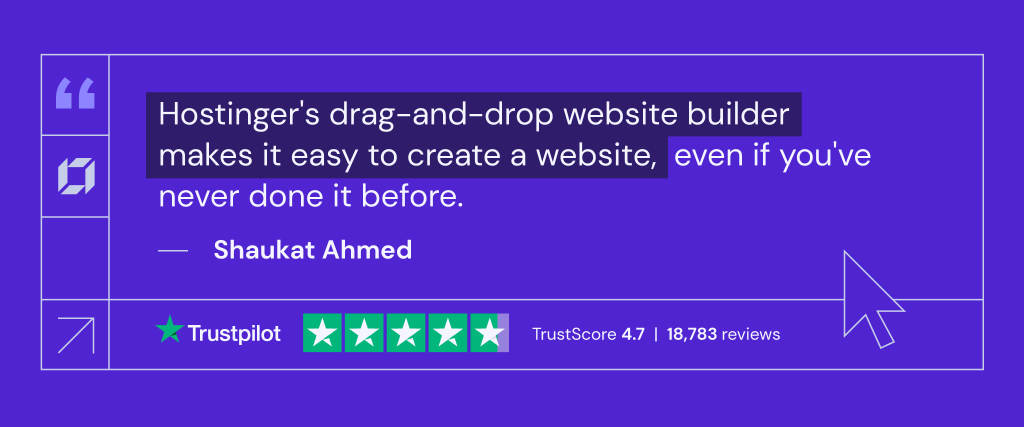How to sell photos online: Best sites and tips for big profits
Selling photos online is a great way for freelance and amateur photographers to show their creativity while making money.
Whether you’re selling stock photos, prints, or digital downloads, understanding the options available can help you decide on the best option for you.
This guide will cover the best platforms for selling photos, covering key features and fees. We will also provide some tips on how to choose the right platform based on your style, market, and business goals.
Top 10 websites to sell photos online
When it comes to selling photos online, choosing the right platform can make a huge difference in terms of visibility, sales, and earnings. Here are the top platforms:
1. Hostinger Website Builder

Unlike generic marketplaces, having your own photography website means you are fully in control of your brand, pricing, and customer interactions.
With Hostinger Website Builder’s drag-and-drop interface, photographers can design their websites without touching a single line of code. This simplifies the setup process, helping you focus on what matters most: your photography.

With your own site, you can, for instance, organize your photos into themed galleries. This helps to create a smooth browsing experience for visitors. All websites built with Hostinger Website Builder are also mobile-friendly, ensuring that potential buyers can easily view and purchase your photos from any device.
Unlike with a third-party marketplace, you have full control over pricing and licensing, too. This flexibility helps you offer bundles of related photos or different resolutions.
The built-in AI tools help create website copy and analyze what your visitors do on different pages, making it easier to adjust the page design. For more information, tips and tricks, follow our guide on how to build an online store with a website builder.
Also, since there are no marketplace commissions, you keep all the profit from your sales. You pay $RM13.99/month and get everything you need to start selling photos online.
2. Shutterstock

Shutterstock is a leading platform for selling stock photos, vectors, videos, and music. Over the last 15 years, it has paid over $1 billion to its contributors.
The platform lets photographers create personalized portfolio pages, submit content, and track earnings in a straightforward, user-friendly manner.
Shutterstock has a tiered earnings structure. Contributors can earn between 15% and 40% commission, with higher rates available as more content is licensed.
While Shutterstock offers great visibility, its tiered commission structure makes it challenging to earn higher payouts without lots of sales.
Also, in a highly competitive marketplace with a large volume of uploads, it can be difficult for photographers to stand out and generate consistent income.
3. Etsy

Etsy is a popular online marketplace that focuses on handmade and vintage goods, but it’s also a great platform for selling digital and physical high-quality images. The site attracts a global audience of buyers looking for unique and creative items, making it a great option for niche photographers.
Selling on Etsy involves three main types of fees: a listing fee, a transaction fee, and a payment processing fee. It costs $0.20 to publish a listing, which lasts for four months or until the item is sold.
Once an item sells, Etsy charges a 6.5% transaction fee on the total sale price, including any shipping or gift-wrapping costs. If you use Etsy Payments, there is an additional payment processing fee of 3% + $0.25, with fees depending on country and currency.
While Etsy gives you access to a global market, the platform’s fees can quickly reduce profit margins, especially for lower-priced items. Additionally, sellers who do not opt out of Offsite Ads may face a 12-15% advertising fee on sales driven by external ads.
4. Adobe Stock

Adobe Stock integrates seamlessly with Adobe Creative Cloud, making it an ideal platform for photographers who are already using Adobe editing tools, like Photoshop or Lightroom.
Contributors to Adobe Stock earn a 33% royalty for images, vectors, and illustrations, and 35% for videos. Photographers can upload their work directly from Adobe Lightroom and use Adobe’s AI-powered keywording tools to improve the visibility of their content.
Adobe Stock contributors also receive free access to Adobe Portfolio, enabling them to quickly create a personal portfolio website to showcase their work.
Due to the platform’s competitive nature, photographers may find the average royalty per sale lower than other premium stock sites. However, the large user base and seamless workflow integration make it a convenient option for those already familiar with Adobe’s ecosystem.
5. Alamy

Alamy is a UK-based stock photography platform offering a huge collection of images, vectors, and videos. It stands out for its high earning potential, paying over $1 million to contributors each month.
Photographers have full control over their content without the platform curating or editing submissions. The site also offers useful tools to help contributors track customer needs and sales trends, helping photographers quickly adjust to market demands.
All contributors begin in the Gold tier, earning 40% of each sale, while Alamy takes 60%. Contributors can move to the Silver tier if they earn less than $250 in gross sales within a revenue year, with a lower commission split of 20% to the contributor and 80% to Alamy.
If contributors generate over $25,000 in gross sales within a revenue year, they qualify for the Platinum tier, earning a 50% commission. Student photographers, on the other hand, get a 100% commission rate for the first two years.
While Alamy offers high commission rates for top-tier contributors, reaching the higher-paying tiers can be challenging for photographers without significant sales volumes.
6. 500px

500px is more than just a marketplace – it’s a social platform that enables photographers to sell their photos, connect with peers, and explore job opportunities.
The platform promotes engagement through its algorithm, helping new photos and photographers be seen. Additionally, the Statistics tool provides insights into how well a photo performs, helping photographers optimize their content.
The platform also hosts weekly creative challenges called Quests, helping photographers gain additional exposure and win prizes. These challenges encourage creativity and foster a sense of community among photographers.
There are three membership levels: Free, Awesome ($6.49/month), and Pro ($12.99/month). Free members earn 60% of net sales through exclusive licensing, while Awesome and Pro members can earn up to 100% commission.
This tiered membership system provides flexibility, helping photographers at all levels benefit from the platform and its social features. However, the platform’s competitive nature and reliance on exclusive licensing may limit the earning potential for some photographers.
7. Dreamstime

Dreamstime is a microstock platform offering a wide range of royalty-free media, including stock photos, vectors, videos, and audio files. With over 200 million files and a user base of more than 40 million, Dreamstime provides photographers access to a large, active audience for selling their work.
Dreamstime offers a revenue share of 25-50% for non-exclusive content, while exclusive files can earn an additional 10% bonus. Those who commit to exclusivity can benefit from a 60% revenue share and receive $0.20 for each approved submission. This incentivizes photographers to provide high-quality, exclusive content.
The platform also features an affiliate program that pays 10% of the gross transaction value for each referred contributor or customer, with referrals lasting up to three years. Affiliates can use various marketing tools, such as banners, badges, and even a WordPress plugin, to attract attention and increase sales.
While Dreamstime provides flexible options for both exclusive and non-exclusive content, the platform’s earnings structure may be less lucrative than that of other premium stock photography sites.
8. Snapped4U

Snapped4U is a platform specifically designed for photographers specializing in portrait and event photography.
It lets photographers create personalized galleries, set their own prices, and sell photos in JPEG format directly to clients. Once payment is made, the photos are delivered to clients via email.
Each photographer has a Personal Page to display their active galleries, with the option to add a bio and personalize the URL. Galleries can also be password-protected to maintain privacy for certain events or clients.
While there are no image upload fees, Snapped4U charges a $10 registration fee.
Additionally, the platform takes a commission per sale: U.S. accounts are charged a $0.50 fee for photos priced at $5 or less, and a 10% fee for photos priced above $5.
For non-U.S. accounts, the fee is $0.60 for photos priced at $5 or less, and 12% for higher-priced images.
Since Snapped4U caters to a specific niche, it’s a convenient option for event and portrait photographers seeking to sell their photos online.
9. Fotomoto

Fotomoto is a print-on-demand eCommerce widget that integrates with websites running on content management systems (CMS) like WordPress and Joomla.
Fotomoto provides a customizable dashboard that lets photographers manage sales, track performance, and efficiently fulfill orders. Once set up, Buy buttons appear next to images on the photographer’s website, helping customers purchase photos directly.
Fotomoto offers three subscription plans to suit different budgets: Free (with a 22% transaction fee), Pro ($10/month + 12% transaction fee), and Pro Plus ($25/month + 10% transaction fee).
While Fotomoto provides a convenient, integrated solution for selling prints, the transaction fees – especially on the free plan – can result in smaller profit margins. Compared to using a website builder with integrated eCommerce tools, the learning curve can also be higher for non-technical users.
10. Getty Images

Getty Images Holdings, Inc. operates three major stock photography platforms: Getty Images, iStock, and Unsplash.
Getty Images is a premium platform that caters to high-profile clients, including media companies and major brands, while iStock offers more affordable microstock content, resulting in higher sales volume at lower prices. Each platform operates with a unique pricing and sales model, providing different earning opportunities for photographers.
Getty Images contributors earn a 20% commission for still images and 25% for video clips.
iStock, on the other hand, offers a tiered commission structure ranging from 15% to 45%, depending on content exclusivity and sales volume.
Contributors to Unsplash+ receive a one-time payment between $5 and $30 per image, which differs from the traditional royalty-based models seen on Getty and iStock.
While Getty Images offers exposure to high-profile clients and lucrative deals for premium content, the platform’s competitive nature and strict submission guidelines can make it challenging for photographers to gain traction.
Expert tips on how to sell photos online
Selling photos online can be a profitable venture, but to maximize your success, it’s important to have a strategy. Below are some expert tips to help you stand out in the competitive market, build a strong online presence, and sell your photos effectively.
Use relevant keywords and descriptions
To make your photos stand out on crowded online platforms, it’s essential to use precise and relevant keywords in your descriptions. Keywords help potential buyers find your photos when they search for specific themes or subjects. Here’s how to do it effectively:
Research keywords
Use tools like Google Keyword Planner, Ahrefs, or SEMrush to identify popular search terms in the photography niche. Look for keywords with a high search volume but low competition.
For example, instead of using a broad term like sunset, try a more specific keyword like golden hour beach sunset photography.
Write descriptive titles
Titles should be concise yet descriptive, capturing the essence of the photo. Instead of Beautiful Landscape, try Misty Mountain Landscape at Sunrise in Autumn.
Optimize photo descriptions
The description should provide more context about the photo, mentioning the location, subject, and mood. This not only helps with SEO but also helps buyers connect emotionally with the image.
For example, a serene early morning shot of a fog-covered mountain range, ideal for calm and nature-themed interior decor.
Include tags
Many platforms let you add tags to your photos. Use a mix of broad and specific tags to increase visibility, such as nature, outdoors, foggy mountains, and sunrise landscape.
Pro Tip
For more in-depth guidance, read our tutorial on SEO for photographers to understand how to get the best visibility on search engines.
Promote your photos using social media
Social media is a powerful tool for photographers to reach a broader audience and drive traffic to their sales platforms. Each social media platform has its unique features that can be leveraged for selling photos:
With its focus on visual content, Instagram is the ideal platform for photographers. Create a cohesive feed that showcases your best work, use relevant hashtags, and engage with your audience through stories and reels.
Instagram Shopping can also be used to link directly to your sales page. Consider running targeted ads to reach potential buyers who are interested in photography.
Pinterest is a great platform for driving traffic to your photography store.
Create themed boards for your collections – for example, Black and White Urban Photography – and pin your photos with detailed descriptions and links to purchase. Pinterest’s visual search feature can help users discover your photos more easily.
Join photography groups and communities to share your work, get feedback, and connect with potential buyers.
Set up a Facebook Page for your photography business where you can run targeted ad campaigns and showcase your photos. Use Facebook Marketplace to sell prints or digital downloads directly.
TikTok
Create behind-the-scenes content, tips, or short videos showcasing your photo collections.
TikTok’s algorithm can boost your content to a wide audience if it resonates, potentially attracting new buyers to your store.
Understand your legal rights to sell photos online
Selling photos online involves legal considerations that every photographer should understand to avoid copyright disputes and ensure their work is protected.
Decide whether to offer your photos under royalty-free or rights-managed licenses. Royalty-free licenses let buyers use the photo without paying for each use, while rights-managed licenses restrict the usage and can be more lucrative if managed correctly.
If your photos feature recognizable people or private property, obtain model or property releases. This is crucial if you plan to sell the photos for commercial purposes.
Protect your photos by adding watermarks when showcasing them online, especially on social media or public websites. You can also register your images with copyright offices to ensure legal protection.
Set competitive and clear pricing
Pricing your photos correctly helps to atttract buyers and ensures you’re adequately compensated. Here are ways to set effective pricing:
- Research the market. Look at how competitors price similar photos on different platforms. Analyze the pricing dynamics for stock photos, prints, and exclusive licenses to stay competitive.
- Offer different pricing tiers. For digital downloads, consider offering multiple resolutions – low, medium, and high – at different price points. For prints, offer various sizes and finishes, such as glossy, matte, or canvas, each priced differently.
- Include clear licensing terms. Clearly state whether the price includes a personal use license, commercial use, or an extended license. This helps prevent misunderstandings and potential legal issues.
- Encourage bundled sales. Create photo bundles based on themes, such as Winter Wonderland or Urban Nightscapes, and offer them at a discounted price compared to buying each photo individually. Bundling can increase the average order value and make buyers feel like they’re getting more value for their money.
Create high-quality, marketable collections
Themed collections can attract buyers looking for a cohesive set of images, and they encourage bulk purchases.
Start by researching current photography trends, such as minimalism, abstract, or vintage. Align your collections with these trends to attract more attention. For example, a Pastel Dreamscape collection could cater to buyers looking for calming, pastel-colored art.
Instead of trying to appeal to everyone, target niche markets like pet lovers, travel enthusiasts, or urban explorers. For example, a Candid Street Photography in Tokyo collection would appeal to those interested in Japanese culture and urban life.
Buyers looking to decorate a space or create a photo album often want a cohesive look. To meet this demand, ensure that each collection maintains a consistent style, color palette, and theme.
Conclusion
Selling photos online is an excellent way for photographers to turn their creativity into a source of income, but success requires selecting the right platform and being smart about building your online presence.
Each platform comes with its own fee structures, commission rates, and advantages, making it crucial to match your business goals with the right platform. Online marketplaces offer a quick start and little responsibility in terms of marketing. Yet the return on investment is relatively low. You can always make your own photography website using Hostinger Website Builder and have full control over your sales and branding, but that will require a little bit more work in the long-run.

Sell photos online FAQ
What types of photos sell the best online?
Photos that capture unique perspectives, high-quality landscapes, authentic lifestyle shots, and trending themes like minimalism or vibrant cityscapes tend to sell well.
Is a professional camera necessary to sell photos online?
While a professional camera can enhance photo quality, it isn’t necessary. Many photographers successfully sell high-quality images taken with smartphones or entry-level cameras.
How much money can I make selling photos online?
Earnings can vary widely depending on the platform, the quality of your photos, and how well you promote them. Some photographers make a few dollars per month, while others earn hundreds or thousands.
Do I keep ownership of my photos if I sell them online?
Most platforms let photographers retain ownership while granting customers the right to use the photo based on the licensing terms. Always read the terms and conditions of the platform you choose to sell on.





Comments
October 29 2023
Need help deciding. Overwhelming info. Have a stunning unfiltered first shot that's magazine worthy. Would be a great postcard How do I sell this?
November 09 2023
Hi there! You can choose to use an online platform or create your own website to sell it directly. If you need assistance or have questions along the way, feel free to reach out to our Customer Success Team ?
November 04 2023
I'm looking to sell my paintings just wondering how i would do it online
November 09 2023
Hello! If you're looking to sell your paintings online, you have a few options to explore. You can either use platforms we mentioned, or create your own website for more control ?
November 20 2023
It's a good training
November 23 2023
It's great to hear that you're having a good experience. I'm sure you're learning a lot and gaining valuable skills ?
May 03 2024
Thankyou so much for your article - I found it well written and very informative ?
May 08 2024
Glad to hear that!
July 26 2024
Hi I would like to start selling my photos. Just not sure how to go about it
July 31 2024
Hi Alex! That's exciting to hear. You can easily try one or more of the websites we recommend in our guide and follow our tips here to boost your sales ;)
November 07 2024
How can I sell my photography
November 13 2024
If you want to sell your photography, I recommend following the steps outlined in our article to get started. You can also create a dedicated photography website by checking out our guide on how to make a photography website, which will help you set up an online portfolio and sell your work ;)
November 11 2024
Hi i would like to start selling my photos. Just not sure how to go about it
November 13 2024
That’s awesome you want to start selling your photos. Just follow the steps in the article, and you'll be well on your way to setting up an online store for your photography. Good luck!